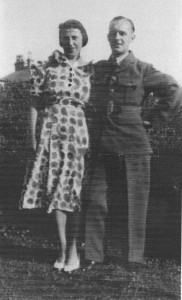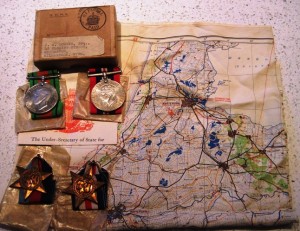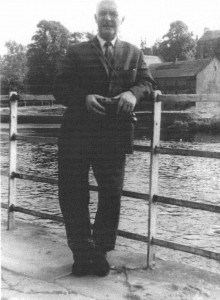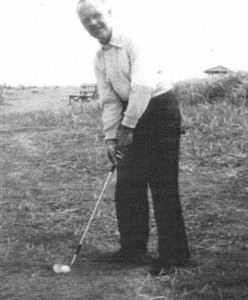Biography of Flight Sergeant John A Downie (Flight Engineer)
 Born in Kilmarnock, Ayrshire in December 1912, John Downie (“Jock” to his crew) was the eldest of seven children, he had four sisters and two brothers. He married his wife Jean in 1936 when he was 24 and she was 25.
Born in Kilmarnock, Ayrshire in December 1912, John Downie (“Jock” to his crew) was the eldest of seven children, he had four sisters and two brothers. He married his wife Jean in 1936 when he was 24 and she was 25.
With thanks to Johns’ friend Mr Tom Wilson of Kilmarnock who, back in 2006 kindly responded with an elegantly hand written letter to an appeal in the local paper (The Kilmarnock Standard) by Mr Brian Angel of the Royal Russell School, Croydon. Sadly both John and his wife had passed away just a few years prior to the appeal for information, they had no children.
In his letter Mr Wilson tells the story of Jean Downie, who was a first cousin to his mother and a regular visitor to their home during the war years when Mr Wilson was a schoolboy. Jean regularly kept the family informed about where John was currently stationed with the RAF and what he was up to, but with one vital omission, Jean believed that her husband was in a relatively safe ground crew post, he had never told her that he was an operational flight engineer, so it came as a huge shock when in mid August 1944 news was received that John was posted as missing over occupied Europe. The previous year in October, Jean had already lost her only brother who died on active service with the Kings Own Scottish Borderers in Italy, her only sister had died aged four in 1918. Towards the end of 1944 the families of the crew of LM658 were still unaware of the fate of their loved ones so Jean Downie found comfort in regular correspondence with other relatives of the missing crew; Mrs Paston-Williams wife of the pilot, Mrs Marjorie Ramsden, wife of the bomb aimer, Mrs Denise Pilfold, sister of the wireless operator and Mrs Shore, sister of the mid-upper gunner. She was also kept busy caring for her mother who lived close by who was still struggling to come to terms with the loss of her only son.
Flt Sgt Downie had been incredibly lucky, he had only suffered minor injuries when he fell from the burning, disintegrating Lancaster, regaining consciousness in time to pull his ‘chute, he was also lucky to be quickly located and hidden by friendly Dutch locals. During his time being sheltered by the underground in Hengelo, John quickly and effectively learned the Dutch language to the extent he could move around freely, even becoming an active member of the local Dutch Resistance. He remained in constant contact with his skipper Flt Lt “Bill” Paston-Williams who was also being sheltered in the town. Both of John Downies’ younger brothers were also on active service, the elder of the two was a POW in Germany after his tank crew were captured during the fall of Greece in 1941 and the younger was a Royal Army Medical Corps orderly with Allied forces in Holland. A more detailed account of John Downie’s final operational flight can be found in The Hood Story.

Liberation day in Hengelo, Harold Paston-Williams is extreme right, middle row, wearing a beret. John Downie is fifth from the left, front row, in hat and light raincoat. Second from the left, front row, in a light raincoat is Roy Fellows, rear gunner of ME732 the 61Squadron Lancaster that crashed on Almelo in Sept 44.
On repatriation after the liberation of Eastern Holland in April 1945 Flt Sgt Downie was returned to his unit and given immediate home leave, he was pale and thin after his time in hiding but soon began to recover. Despite the obvious delight and relief of his wife and family, celebrations were kept very personal and low key as neither John nor Jean wanted any kind of publicity and most important of all they were mindful that five members of the crew would never be coming home. John soon returned to his unit where a promotion to Warrant Officer quickly followed. He remained in the Royal Air Force until demobilisation soon after the end of the war, by which time he was known to all and sundry as “The Flying Dutchman!” He became a member of the ”Caterpillar Club” formed for airmen whose lives had been saved by parachute, their emblem, worn adjacent to any medals was a small silver crest depicting a collapsed chute being gathered, which at first glance resembled a caterpillar, hence the name!

John Downie’s silk escape map of the Netherlands and his medal collection; 1939-45 Star, France and Germany Star, WWII Medal and Defence Medal. (Courtesy of mr Richard Jones)
On return to civilian life John became a travelling engineer for the “British United Shoe Sewing Machine Company,” carrying out the service and maintenance of shoe manufacturing machinery. In his spare time he was a keen golfer and in later life he
 discovered he had a gift for painting in watercolours. Throughout his life John kept in regular touch with the Dutch family that sheltered him in Hengelo, they even visited John and Jean in Kilmarnock. John Downie was indeed an adopted son of the Netherlands, it would forever be a part of him!
discovered he had a gift for painting in watercolours. Throughout his life John kept in regular touch with the Dutch family that sheltered him in Hengelo, they even visited John and Jean in Kilmarnock. John Downie was indeed an adopted son of the Netherlands, it would forever be a part of him!
Many thanks also to Mr Laurie Pilfold, nephew of the wireless operator Flt Sgt Laurence Watts, who has kindly given me access to correspondence between his Mother Mrs Denise Pilfold and Mrs Downie. Further contact with relatives or indeed anyone who can add to this archive will always be welcomed.
Alan J Barrow